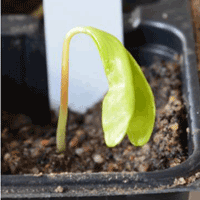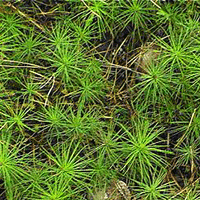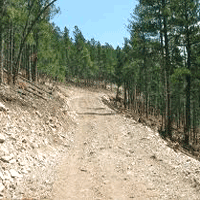The aim of this study was to modify several existing biological models by including several predictive variables that take into account the effect of climatic factors on tree height growth. Tree height was measured from 2007 to 2014 on 18 trees for each of the following species: Eucalyptus urophylla × Eucalyptus grandis, Parapiptadenia rigida, Peltophorum dubium, Mimosa scabrella and Schizolobium parahybae. Different existing nonlinear models were fitted to the observed data, and the best fitting models were selected. The inclusion of climatic variables into the selected models (mainly minimum temperature and rainfall) improved their predictions of tree height growth with age, and provided more accurate estimates than those obtained by traditional nonlinear models. Simulations were carried out to explore the variation of tree height growth under different minimum temperature and precipitation regimes. The effects of frost and rainfall variation on height growth curves and their consequences for forest management are discussed.
Keywords
, , ,
Citation
Elli EF, Caron BO, Behling A, Eloy E, Queiróz De Souza V, Schwerz F, Stolzle JR (2017). Climatic factors defining the height growth curve of forest species. iForest 10: 547-553. - doi: 10.3832/ifor2189-010
Academic Editor
Giustino Tonon
Paper history
Received: Aug 03, 2016
Accepted: Feb 19, 2017
First online: May 05, 2017
Publication Date: Jun 30, 2017
Publication Time: 2.50 months
© SISEF - The Italian Society of Silviculture and Forest Ecology 2017
Open Access
This article is distributed under the terms of the Creative Commons Attribution-Non Commercial 4.0 International (https://creativecommons.org/licenses/by-nc/4.0/), which permits unrestricted use, distribution, and reproduction in any medium, provided you give appropriate credit to the original author(s) and the source, provide a link to the Creative Commons license, and indicate if changes were made.

Breakdown by View Type
(Waiting for server response...)
Article Usage
Total Article Views: 51588
(from publication date up to now)
Breakdown by View Type
HTML Page Views: 42513
Abstract Page Views: 3832
PDF Downloads: 3833
Citation/Reference Downloads: 29
XML Downloads: 1381
Web Metrics
Days since publication: 3152
Overall contacts: 51588
Avg. contacts per week: 114.57
Article Citations
Article citations are based on data periodically collected from the Clarivate Web of Science web site
(last update: Mar 2025)
Total number of cites (since 2017): 15
Average cites per year: 1.67
Publication Metrics
by Dimensions ©
Articles citing this article
List of the papers citing this article based on CrossRef Cited-by.
(1)
Allen H, Albaugh TJ (1999)Ecophysiological basis for plantation production: a loblolly pine case study. Bosque 20: 3-8.
CrossRef |
Gscholar
(2)
Armstrong RA, McGhee R (1980)Competitive exclusion. American Naturalist 115: 151-170.
CrossRef |
Gscholar
(3)
Augspurger CK (2011)Frost damage and its cascading negative effects on
Aesculus glabra. Plant Ecology 212: 1193-1203.
CrossRef |
Gscholar
(4)
David HC, Péllico Netto S, Arce JE, Corte A, Marinheski Filho A, Behling A (2015)Updating of dominant height growth modeling and site index of
Pinus taeda L. in southern Brazil. Australian Journal of Basic and Applied Sciences 9: 115-125.
Online |
Gscholar
(5)
Diamantopoulou MJ, Ozçelik R (2012)Evaluation of different modeling approaches for total tree-height estimation in Mediterranean region of Turkey. Forest Systems 21: 383-397.
CrossRef |
Gscholar
(6)
Dünisch O, Montóia VR, Bauch J (2003)Dendroecological investigations on
Swietenia macrophylla King and
Cedrela odorata L. (Meliaceae) in the central Amazon. Trees 17: 244-250.
Online |
Gscholar
(7)
Fitter AH (1987)An architectural approach to the comparative ecology of plant root systems. New Phytologist 106: 61-77.
CrossRef |
Gscholar
(8)
Gatti MG, Campanello PI, Montti LF, Goldstein G (2008)Frost resistance in the tropical palm
Euterpe edulis and its pattern of distribution in the Atlantic Forest of Argentina. Forest Ecology and Management 256: 633-640.
CrossRef |
Gscholar
(9)
Grogan J, Schulze M (2012)The impact of annual and seasonal rainfall patterns on growth and phenology of emergent tree species in southeastern Amazonia, Brazil. Biotropica 44: 331-340.
CrossRef |
Gscholar
(10)
Heber U, Santarius KA (1973)Cell death by cold and heat and resistance to extreme temperatures: mechanisms of hardening and dehardening. In: “Temperature and life” (Precht H, Christophersen J, Hensel H, Larcher W eds). Springer-Verlag, Berlin, Germany, pp. 232-292.
Gscholar
(11)
Hendrickson L, Ball MC, Wood JT, Chow WS, Furbank RT (2004)Low temperature effects on photosynthesis and growth of grapevine. Plant, Cell and Environment 27: 795-809.
CrossRef |
Gscholar
(12)
Hunter IR, Gibson AR (1984)Predicting
Pinus radiata site index from environmental variables. New Zealand Journal of Forestry Science 14: 53-64.
Online |
Gscholar
(13)
Inouye DW (2000)The ecological and evolutionary significance of frost in the context of climate change. Ecology Letters 3: 457-463.
CrossRef |
Gscholar
(14)
Inouye DW (2008)Effects of climate change on phenology, frost damage, and floral abundance of montane wildflowers. Ecology 89: 353-362.
CrossRef |
Gscholar
(15)
Jiang L, Li Y (2010)Application of nonlinear mixed-effects modeling approach in tree height prediction. Journal of Computers 5: 1575-1581.
CrossRef |
Gscholar
(16)
Jose S, Gillespie AR, Pallardy SG (2004)Interespecific interactions in temperate agroforestry. Agroforestry Systems 61: 237-255.
CrossRef |
Gscholar
(17)
Lloyd J, Farquhar GD (2008)Effects of rising temperatures and CO
2 on the physiology of tropical forest trees. Philosophical Transactions of the Royal Society B: Biological Sciences 363: 1811-1817.
CrossRef |
Gscholar
(18)
Lohmus K, Oja T, Lasn R (1989)Specific root area: soil characteristic. Plant and Soil 119: 245-249.
CrossRef |
Gscholar
(19)
Luken JO (1990)Gradual and episodic changes in the structure of
Rhus typhina clones. Bulletin of the Torrey Botanical Club 117: 221-225.
CrossRef |
Gscholar
(20)
Mansfield ER, Helms BP (1982)Detecting multicollinearity. The American Statistician 36: 158-160.
CrossRef |
Gscholar
(21)
Montgomery DC, Peck EA, Vining GG (2012)Introduction to linear regression analysis (5th edn). John Wiley and Sons, New Jersey, USA, pp. 507.
Online |
Gscholar
(22)
Mooney HA (1977)Frost sensitivity and resprouting behavior of analogous shrubs of California and Chile. Madroño 24: 74-78.
Online |
Gscholar
(23)
Morales MS, Villalba R, Grau HR, Paolini L (2004)Rainfall-controlled tree growth in high-elevation subtropical treelines. Ecology 85: 3080-3089.
CrossRef |
Gscholar
(24)
Neter J, Wasserman W (1974)Applied linear statistical models: regression, analysis of variance, and experimental designs. Richard D. Irwin, Homewood, IL, USA, pp. 842.
Gscholar
(25)
Newman EI (1973)Competition and diversity in herbaceous vegetation. Nature 244: 310-1310.
CrossRef |
Gscholar
(26)
Perin J, Hébert J, Brostaux Y, Lejeune P, Claessens H (2013)Modelling the top-height growth and site index of Norway spruce in Southern Belgium. Forest ecology and management 298: 62-70.
CrossRef |
Gscholar
(27)
Prior LD, Bowman DMJS (2014)Big eucalypts grow more slowly in a warm climate: evidence of an interaction between tree size and temperature. Global change biology 20: 2793-2799.
CrossRef |
Gscholar
(28)
Rais A, Van De Kuilen JWG, Pretzsch H (2014)Growth reaction patterns of tree height, diameter, and volume of Douglas-fir (
Pseudotsuga menziesii [Mirb.] Franco) under acute drought stress in Southern Germany. European Journal of Forest Research 133: 1043-1056.
CrossRef |
Gscholar
(29)
Rao CR (1973)Linear statistical inference and its applications. Wiley Series in Probability and Statistics, John Wiley & Sons, New York, USA, pp. 560.
CrossRef |
Gscholar
(30)
Rasche L, Fahse L, Zingg A, Bugmann H (2012)Enhancing gap model accuracy by modeling dynamic height growth and dynamic maximum tree height. Ecological Modelling 232: 133-143.
CrossRef |
Gscholar
(31)
Regazzi AJ, Silva CHO (2010)Testes para verificar a igualdade de parametros e a identidade de modelos de regressão não-linear em dados de experimento com delineamento em blocos casualizados [Tests for model identity and parameter equality with nonlinear regression models in data from randomized complete block design]. Ceres 57: 315-320. [in Portuguese]
CrossRef |
Gscholar
(32)
Rohner B, Bugmann H, Bigler C (2013)Estimating the age-diameter relationship of oak species in Switzerland using nonlinear mixed-effects models. European Journal of Forest Research 132 (5-6): 751-764.
CrossRef |
Gscholar
(33)
Sanquetta CR, Behling A, Dalla Corte AP, Netto SP, Rodrigues AL, Simon AA (2014)A model based on environmental factors for diameter distribution in black wattle in Brazil. Plos ONE 9: e100093.
CrossRef |
Gscholar
(34)
Schippers P, Sterck F, Vlam M, Zuidema PA (2015)Tree growth variation in the tropical forest: understanding effects of temperature, rainfall and CO
2. Global Change Biology 21: 2749-2761.
CrossRef |
Gscholar
(35)
Snowdon P, Benson ML, Woollons RC (1998)Incorporation of climatic indices into models of growth of
Pinus radiata in a spacing experiment. New Forests 16: 101-123.
CrossRef |
Gscholar
(36)
Snowdon P, Jovanovic T, Booth TH (1999)Incorporation of indices of annual climatic variation into growth models for
Pinus radiata. Forest Ecology and Management 117: 187-197.
CrossRef |
Gscholar
(37)
Strain BR (1966)The effect of a late spring frost on the radial growth of variant quaking aspen biotypes. Forest Science 12: 334-337.
Online |
Gscholar
(38)
Subedi N, Sharma M (2013)Climate-diameter growth relationships of black spruce and jack pine trees in boreal Ontario, Canada. Global Change Biology 9: 505-516.
CrossRef |
Gscholar
(39)
Trouvé R, Bontemps JD, Seynave I, Collet C, Lebourgeois F (2015)Stand density, tree social status and water stress influence allocation in height and diameter growth of
Quercus petraea (Liebl.). Tree physiology 35: 1035-1046.
CrossRef |
Gscholar
(40)
Uzoh FC, Oliver WW (2006)Individual tree height increment model for managed even-aged stands of ponderosa pine throughout the western United States using linear mixed effects models. Forest Ecology and Management 221: 147-154.
CrossRef |
Gscholar
(41)
Van Der Sleen P, Groenendijk P, Vlam M, Anten NP, Boom A, Bongers F, Pons TL, Teburg G, Zuidema PA (2014)No growth stimulation of tropical trees by 150 years of CO
2 fertilization but water-use efficiency increased. Nature Geoscience 8: 24-28.
CrossRef |
Gscholar
(42)
Wang W, You S, Wang Y, Huang L, Wang M (2011)Influence of frost on nutrient resorption during leaf senescence in a mangrove at its latitudinal limit of distribution. Plant and Soil 342: 105-115.
CrossRef |
Gscholar
(43)
Woollons RC, Snowdon P, Mitchell ND (1997)Augmenting empirical stand projection equations with edaphic and climatic variables. Forest Ecology and Management 98: 267-275.
CrossRef |
Gscholar
(44)
Zeide B (1993)Analysis of growth equations. Forest Science 39: 594-616.
Online |
Gscholar
(45)
Zhang PC, Liu J (2001)Developing and validating nonlinear height-diameter models for major tree species of Ontario’s boreal forests. Northern Journal of Applied Forestry 18: 87-94.
Online |
Gscholar
(46)
Zhang L, Bi H, Cheng P, Davis CJ (2004)Modeling spatial variation in tree diameter-height relationships. Forest Ecology and Management 189: 317-329.
CrossRef |
Gscholar


















